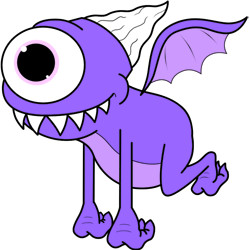The “Flying Purple People Eater Song” is a classic, and for many, it’s synonymous with Halloween. Every October, as costumes are donned and spooky decorations emerge, this novelty tune often resurfaces, filling the airwaves and dance floors with its quirky charm. Generations have grown up associating it with trick-or-treating and costume parties, cementing its place in the Halloween soundtrack.
 Cartoon illustration of the Flying Purple People Eater, a one-eyed, one-horned creature associated with the popular 1958 novelty song.
Cartoon illustration of the Flying Purple People Eater, a one-eyed, one-horned creature associated with the popular 1958 novelty song.
However, the story behind the “flying purple people eater song” is full of surprises. Contrary to popular belief, this enduring hit wasn’t actually intended as a Halloween anthem. It might be surprising to learn that Sheb Wooley’s “Purple People Eater” actually took flight in the spring of 1958, becoming a massive summer hit, long before pumpkins and spooky season were even on the horizon. Released in May, it soared through the charts during the summer months, capturing the carefree spirit of the season.
The creation of this iconic “flying purple people eater song” is as whimsical as the song itself. Sheb Wooley, the singer and songwriter, drew inspiration from a simple joke he overheard from a friend’s child. This lighthearted spark ignited his creativity, and legend has it that the entire song was composed in under an hour. This spontaneous origin story perfectly complements the song’s playful and infectious nature.
As “Purple People Eater” climbed the music charts in July 1958, teenagers across the nation embraced its upbeat rhythm and comical narrative. The song tells the tale of a peculiar creature whose ambition is to join a rock and roll band. Adding to the song’s novelty is the distinctive, high-pitched voice of the “people eater,” reminiscent of The Chipmunks. This unique vocal effect was achieved through tape speed manipulation, a relatively innovative recording technique at the time, further contributing to the song’s groundbreaking sound.
Beyond its unexpected summer release, another common misconception surrounds the appearance of the titular creature in the “flying purple people eater song.” Despite the seemingly straightforward title suggesting a purple monster, the lyrics themselves never actually describe the “people eater” as purple. Instead, the song specifies that the people being eaten are purple. Yet, popular culture has consistently depicted the creature as a purple, one-eyed, one-horned being, often complete with wings, showcasing how interpretations can sometimes diverge from the original source material.
Regardless of these factual nuances, the “flying purple people eater song” and its associated imagery have undeniably become ingrained in Halloween celebrations. Its monstrous theme, catchy melody, and danceable beat have made it a perennial favorite for children’s Halloween albums and spooky-themed events for decades.
Many listeners, caught up in the song’s infectious energy, might not have fully deciphered the lyrics delivered in the creature’s sped-up voice. However, a closer listen reveals the song’s true comedic genius. As highlighted by radio DJs like Alan Seltzer from WCWP’s The Grooveyard, paying attention to the complete lyrics unveils a layer of humor that often goes unnoticed, adding another dimension to the song’s enduring appeal.
In conclusion, while the “flying purple people eater song” is firmly cemented in our minds as a Halloween staple, its origins as a spring release and the subtle lyrical details offer a richer, more nuanced understanding of this novelty classic. It remains a testament to the power of a catchy tune and a whimsical idea, proving its staying power as both a summer hit and a Halloween favorite for generations to come.
